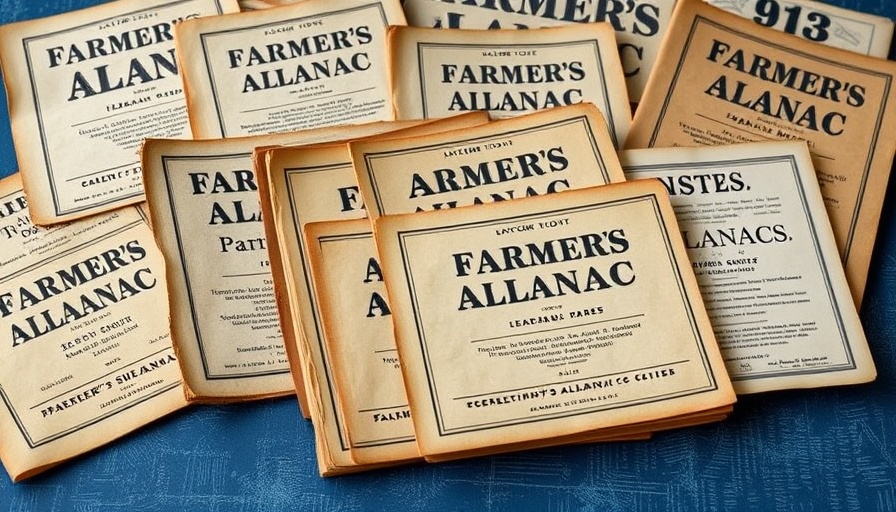
The History of the Farmer's Almanac: A Timeless Tradition
The Farmer's Almanac is more than just a book of weather forecasts; it represents a rich tapestry of history and tradition. Originating in 1792, the original Farmer’s Almanac was crafted by Robert B. Thomas for the farmers of Massachusetts, providing them with weather predictions crucial for successful planting and harvesting. This almanac distinguished itself by promising 'new, useful, and entertaining' insights, which contributed to its longstanding popularity.
Its counterpart emerged later in 1818, aiming to cater to an equally demanding audience. Both publications have weathered the test of time, existing alongside modern forecasting technology. This blend of antiquity and modernity is what makes the story of the Farmer's Almanac so fascinating.
Understanding the Almanac's Methodology
Despite its deep historical roots, the methodologies employed by the Farmer's Almanac remain somewhat shrouded in mystery. The Old Farmer's Almanac claims to base its forecasts on historical weather patterns, while the Farmers' Almanac incorporates additional factors spanning from solar activity to astrology. This blend of science and traditional belief raises questions about the reliability of almanac predictions.
Dr. Hansi Singh, a leading Earth scientist, emphasizes that while these predictions may be rooted in historical practices, the precision of modern meteorological methods far surpasses those of traditional almanacs. Thus, while the Almanacs hold charm and traditions appealing to many, one should approach their forecasts with a degree of skepticism.
The Cultural Impact of the Farmer's Almanac
For generations, the Farmer's Almanac has woven itself into the fabric of American culture. Americans often turn to the almanac not just for weather predictions but for gardening advice, celestial events, and even folklore. This cultural significance illustrates the communal nature of using the almanac—it fosters a unique connection between those who seek guidance from its pages.
The traditions encapsulated within the Farmer's Almanac echo the sentiments of rural life and the values of self-sufficiency, emphasizing how historical practices continue to resonate in contemporary society.
Modern vs. Traditional Weather Forecasting
As we stride deeper into the 21st century, the advancement of technology has overshadowed many traditional forecasting methods. Mobile apps and sophisticated satellite imagery now dominate the weather landscape, offering real-time data that eclipses the seasonal forecasts of the almanac. This begs the question: how does the public perceive these traditional forecasts given the high-level accuracy provided by modern methods?
While modern forecasts offer unparalleled precision, many people still seek the nostalgic comfort that the Farmer's Almanac provides. Its recommendations for seasonal celebrations, gardening tips, and weather folklore can invoke a sense of community often missing in our digital age.
Potential Misconceptions About the Farmer’s Almanac
Despite its popularity, misconceptions about the Farmer's Almanac abound. A common belief is that it can predict the weather with the same accuracy as more modern methods. In reality, while some people swear by its forecasts, the almanac serves more as a conversation starter and a cultural artifact than a reliable source for daily weather.
Moreover, its reliance on historical patterns makes it more of a thematic guide rather than a precise radar for short-term weather planning. This distinction is crucial for readers who may rely on its predictions for gardening or planning outdoor events.
Your Takeaway: Embrace the Wisdom, Balance with Modernity
The Farmer's Almanac enjoys a cherished place among weather enthusiasts and casual readers alike. It provides a unique combination of historical insights, folklore, and light-hearted advice that brings joy to its audience.
As you navigate your gardening schedules, plan your outdoor activities, or simply revel in the changing seasons, the almanac can serve as a companion. While embracing the cutting-edge technology of today, don't shy away from the wisdom of ages past. Understanding how to blend these insights can guide you toward enriching experiences and informed decisions.
If you're curious about weather patterns, consider exploring both traditional resources like the Farmer’s Almanac alongside modern forecasting methods. This well-rounded approach will undoubtedly serve you well in your outdoor adventures!
 Add Row
Add Row  Add
Add 




Write A Comment